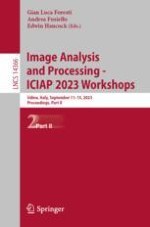The two-volume set LNCS 14365 and 14366 constitutes the papers of workshops hosted by the 22nd International Conference on Image Analysis and Processing, ICIAP 2023, held in Udine, Italy, in September 2023.
In total, 72 workshop papers and 10 industrial poster session papers have been accepted for publication.
Part II of the set, volume 14366, contains 41 papers from the following workshops:– Medical Imaging Hub:• Artificial Intelligence and Radiomics in Computer-Aided Diagnosis (AIR-CAD)• Multi-Modal Medical Imaging Processing (M3IP)• Federated Learning in Medical Imaging and Vision (FedMed)– Digital Humanities Hub:• Artificial Intelligence for Digital Humanities (AI4DH)• Fine Art Pattern Extraction and Recognition (FAPER)• Pattern Recognition for Cultural Heritage (PatReCH)• Visual Processing of Digital Manuscripts: Workflows, Pipelines, BestPractices (ViDiScript)
